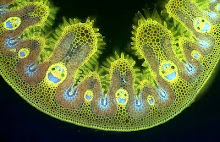I've had this specimen of fork-leaved sundew Drosera binata for about a decade and it now fills a 10 inch pot and carries about 200 sticky-tentacled leaves. It's a death-trap for flies and would be quite capable of catching bumblebees if it had access to them.
Sundews face a dilemma - the need to capture and digest flies to supplement the meagre supplies of nitrogen in the soils in which they grow, while simultaneously using the services of insects to pollinate their flowers. The solution, as in many insectivorous plants, is to separate flowers and lethal leaves with a long flower stalk. It works pretty well in this case - the plant always sets plenty of dust-like seeds that germinate easily in surrounding flower pots in the conservatory, provided their soil surface is wet.
I particularly like the way the forked leaves unfurl - it's a bit like rolling out a deadly red carpet for passing insects ....
... and there is an air of menace about it in the final stages - like raised arms with clenched fists. The common name of the plant is especially apt - it looks stunning when it catches the first rays of sun in the morning, when all those drops of mucilage sparkle like dew-drops.
Sundews were amongst Charles Darwin's favourite plants and he experimented with them in great detail, demonstrating that they released digestive enzymes when presented with animal protein (egg albumen in his experiments).
He noted that when a few tentacles captured a fly the surrounding ones responded by curling towards and then over it, often followed by the whole leaf folding over the prey, creating what he referred to as a 'vegetable stomach'. You can see how some of the longer hairs are curling towards this fly within a couple of minutes of it becoming stuck.
Each sticky-tipped hair is a complex strucure, with a glandular head that secretes mucilage (which is remarkably resistant to being washed away) and then enzymes that digest the prey after it dies of exhaustion during its struggle to escape. The products of digestion are transported down the stalk to the leaf in a double layer of cells in the hair stalk that pass the digestion products from cell to cell.
Darwin's book Insectivorous Plants contains detailed accounts of his experiments with this plant and can be downloaded here.



















